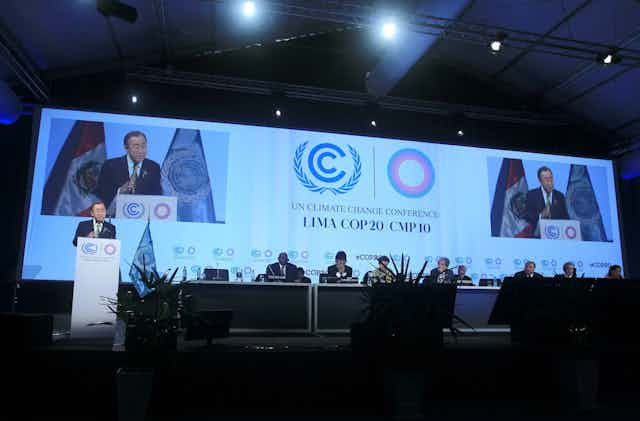Could the preoccupation with legally binding targets sink the next climate deal in Paris in 2015?
In the run-up to this week’s Lima talks, widely seen as a precursor to the Paris summit, the Abbott government was accused of attempting to set up the talks for failure by insisting upon legally binding targets for emissions cuts.
At the Lima summit, foreign minister Julie Bishop seems to have softened that stance considerably, backing down on this demand but still insisting that her preference is for targets to be legally binding, to avoid them being seen as “just an aspiration”.
Australia’s previous hardline position led to accusations that it is attempting to discredit and undermine a Paris agreement that will almost certainly not have legally binding targets (although there is also a suggestion that Australia is pushing a much more conciliatory line in Lima than it is at home).
Strange bedfellows
But while all this might be seen as political posturing on Australia’s part, there are other nations – the small island developing states, African countries, and many others – who are earnestly insisting on a legally binding targets, and have done all along.
They make strange bedfellows with Australia, to say the least. Why would the most vulnerable and concerned about climate change share a position with a government renowned for its climate scepticism and obstructionism?
The answer is that both are pushing for a legally binding outcome for polar opposite reasons.
For Australia, there are still legitimate suspicions that it is trying to set up Paris for failure, although Bishop has softened in this respect. For the most vulnerable nations to climate change, it is a sincere push for the most effective solution.
And what is even stranger is that both are right.
Targets and pledges
As I have argued previously, a legally binding deal is probably necessary to address climate change effectively. Despite some advantages to a non-binding, “pledge-based” system, it is trumped by the certainty and reliability that international law would provide.
Unfortunately, however, there is also the simple matter of political feasibility. A legally binding deal is likely to be left in the cold by the largest polluters.
The United States, for instance, requires a two-thirds supermajority vote in its Senate to ratify an international treaty. It has previously failed to pass the Kyoto Protocol through the Senate, and given that the conservative Republican Party recently gained control of both sides of Congress, it seems that US ratification of an ambitious and binding agreement is a foregone dream.
In turn, China, the world’s largest greenhouse emitter, seems unlikely to ratify any agreement that doesn’t include the United States. Thus a deal with legal targets will probably not have the United States or China on board, despite the strong, non-legislated pact agreed by the two nations last month.
It is this underlying politics that has led many to speculate that Australia’s push for a deal on legally binding emissions cuts is not being done in good faith.
But the repeated assertion that a deal without China or the United States is worthless, is completely misleading. The majority of successful past multilateral agreements did not have universal beginnings. The original Montreal Protocol left out many important countries, including China. The General Agreement on Tariffs and Trade only featured a small number of developed countries. It eventually snowballed into a wider, larger structure: the World Trade Organisation. The same can be said for the European Union, or even the United Nations.
The conventional wisdom of having universal agreements is only a recent phenomenon. It is an ideal that does not have much support from history or academia. That said, the leadership of a major power seems to be an essential ingredient for multilateral success.
To some extent, international treaties are a case of picking your poison. A highly ambitious, legally binding climate agreement will probably preclude the US and China from signing up. An agreement with the US is going to have to be something far weaker and without legally binding targets. In other words, the agreement will be watered down as the price of admission for more participants. On the other hand, strong, binding agreements come at the cost of having fewer countries involved.
Getting the US to ratify an international climate treaty has proved to be reoccurring Achilles heel for negotiations. The insistence upon US involvement has generally led to weaker treaties that the US won’t ratify anyway – hence the call from British climate economist Nicholas Stern for legally binding requirements to be dropped.
A stronger agreement without broad participation but which grows over time isn’t necessarily a bad idea. Either that, or a creative new approach to legality and US participation will be needed.
The pursuit of legally binding targets may very well crash the Paris negotiations. But if we shift to accommodate a pledge-based system, we need to make sure it isn’t just as weak.

